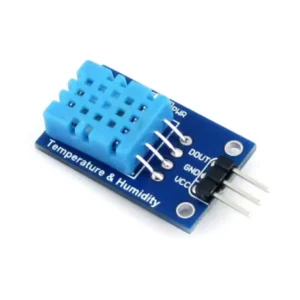The DHT11 Temperature and Humidity Sensor senses, measures and regularly reports the relative humidity in the air.
It measures both moisture and air temperature. The warmer the air is, the more moisture it can hold, so relative humidity changes with fluctuations in the temperature.
Humidity sensors detect the relative humidity of immediate environments in which they are placed.
They measure both moisture and temperature in the air and express relative humidity as a percentage of the ratio of moisture in the air to the maximum amount that can be held in the air at the current temperature.
As the air becomes hotter, it holds more moisture, so the relative humidity changes with the temperature.
Related Article: DHT11 Temperature and Humidity Sensor With Arduino

DHT11 Pinout
When working with the DHT11 Temperature & Humidity Sensor, understanding its pinout is essential. The sensor has a total of three pins: VCC, DOUT, and GND.
The VCC pin is used to power the sensor and typically requires 3-5V DC input. The GND pin is connected to the ground of your circuit. Next is the DOUT pin, which sends the temperature and humidity readings to your microcontroller or Arduino board.
How Does the DHT11 Sensor Work?
The DHT11 sensor operates by utilizing a thermistor to measure temperature and a capacitive humidity sensor to gauge humidity levels. When the sensor receives a command from the microcontroller, it starts the data acquisition process.
Initially, the thermistor measures ambient temperature by detecting changes in its resistance according to temperature variations. Simultaneously, the capacitive humidity sensor determines relative humidity levels based on capacitance changes caused by moisture in the air.
Once both measurements are obtained, they are converted into digital signals that can be easily interpreted by the microcontroller for further processing or display purposes.
Difference between DHT11 and DHT22
The different versions of the DHT11 temperature and humidity sensor, they are similar in look and have the same pinout configuration, but have different characteristics and specifications:
DHT11
- Cheaper in cost
- The required power supply of 3 to 5v.
- 5% accuracy for humidity reading and 20-80% good.
- ±2°C accuracy for temperature reading.
- Max 1 Hz sampling rate (once every second)
- Size 15.5mm x 12mm x 5.5mm
DHT22
- Cost more than DHT11.
- The required power supply of 3 to 5v.
- 2-5% accuracy for humidity reading and 0-100% good.
- ±0.5°C accuracy for temperature reading and -40 to 125°C good.
- Max 0.5 Hz sampling rate (once every 2 seconds)
- Size 15.1mm x 25mm x 7.7mm
Applications of the DHT11 Sensor
The DHT11 temperature and humidity sensor is a versatile device with various applications across different industries.
- One of the most common uses of the DHT11 sensor is in weather stations to monitor environmental conditions accurately. Its ability to measure both temperature and humidity makes it an essential tool for meteorological purposes.
- The DHT11 sensor is widely use in smart home systems to control heating, ventilation, and air conditioning (HVAC) systems based on real-time data. This helps improve energy efficiency and comfort levels for residents by adjusting settings according to current conditions.
- Furthermore, the DHT11 sensor finds applications in agricultural settings for monitoring greenhouse conditions such as temperature and humidity levels. By providing crucial data, farmers can optimize growing conditions for plants and crops leading to better yields.